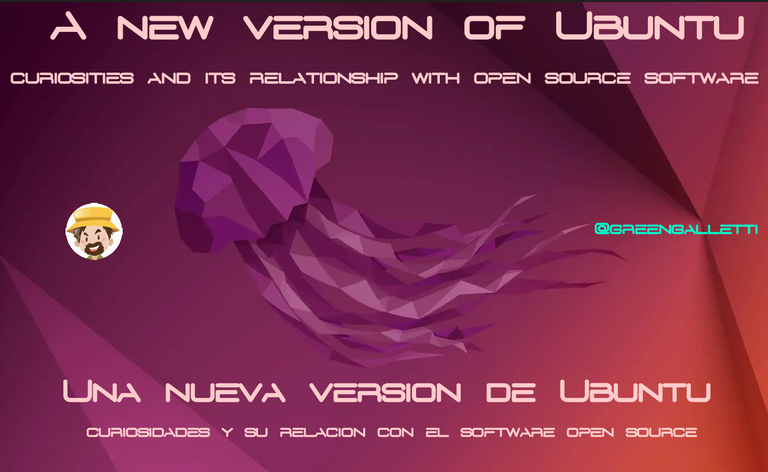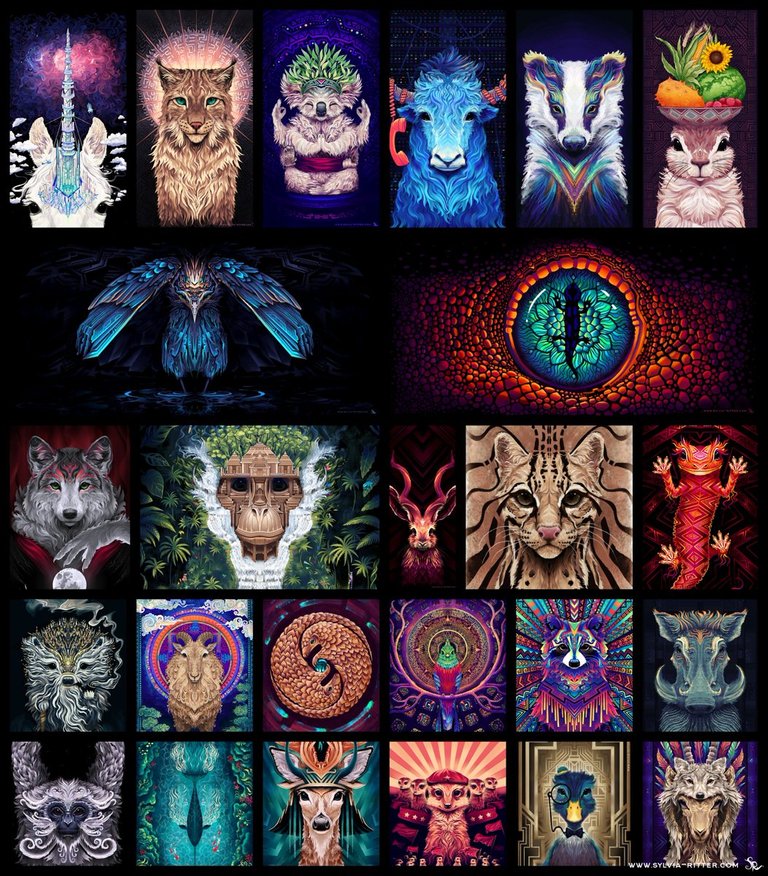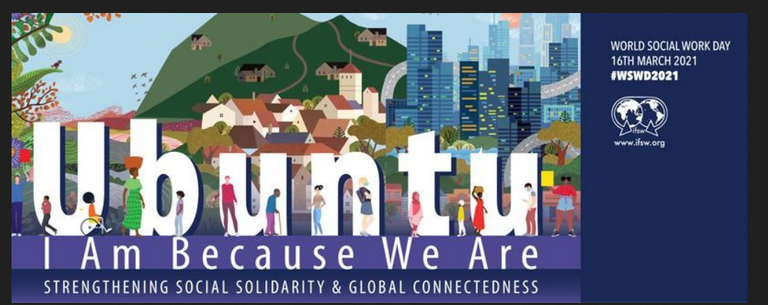A new version of Ubuntu, curiosities and its relationship with open source software. / Una nueva versión de Ubuntu, curiosidades y su relación con el software open source. |OPINION| ENG-ESP

Exactly today Ubuntu, one of the most popular Linux kernel-based distributions in recent years (and perhaps in the entire history of Linux and free and open source software) has released its version 22.04, codenamed "Jammy Jellyfish" which translated into English would give something like Jellyfish with Marmalade or the combination between these two words that #hivers want to choose.
For those who are not familiar with the Ubuntu project in terms of names, let's say that since the beginning (back in 2004) has chosen the combination between a noun animal name and an adjective respecting two basic rules: the first is that they are two letters of the alphabet the same, obviously starting from A -when we reached Z we started again-, and the second is that each version is absolutely correlative to the previous one in alphabetical order.

Exactamente, hoy Ubuntu, una de las distribuciones basadas en el kernel Linux más populares de los últimos años (y tal vez de toda la historia de Linux y del software libre y open source) ha publicado su versión 22.04, nombre en código "Jammy Jellyfish" que traducido al español daría algo así como Medusa con Mermelada o la combinación entre estas dos palabras que los #hivers quieran elegir.
Para aquellos a los cuales el proyecto Ubuntu no les sea familiar en cuanto a los nombres, digamos que desde el inicio (allá por el lejano 2004) ha elegido la combinación entre un sustantivo nombre de animal y un adjetivo, respetando dos reglas básicas: la primera es que sean dos letras del alfabeto iguales, comenzando obviamente desde la A -cuando se llegó a la Z se comenzó de nuevo-, y la segunda es que cada versión sea absolutamente correlativa de la anterior en cuando al orden alfabético.
Getting to know Ubuntu, the names of its versions, the animals and their adjectives. / Conociendo Ubuntu, los nombres de sus versiones, los animales y sus adjetivos.

Let me explain with an example: in this new version Mark Shuttleworth -usually the name is chosen by the founder of Ubuntu from his personal blog- had to choose an animal and an adjective starting with the letter J. The name of the animal is usually not a problem, the name of the adjective that identifies it is sometimes more complicated. Or Shuttleworth just has fun choosing it.
Thus we have had for example that the first version of Ubuntu (the 4.10 was called Warty Warthog while a year later the 5.10 assumed the name of Breezy Badger and so on until today.
At that time - or rather in the first two releases - there was no such thing as the strictness of the spruce letters in strict order from A onwards. Indeed, the first one was with W, perhaps because its founder never imagined that the popularity of Ubuntu would take it so far in time, and the second one was with H Hoary Hedgehog, published in April 2005.
And here I make a brief clarification to avoid confusion with the names: the numbering of each version (it is a biannual distribution with a release in the month of April and another in the month of October) responds to the year and month of release. For example, the current 2022.04 means that it was released this year in April.
With the exception of the year 2006 called Dapper Drake (Elegant Duck) which suffered a delay of two months (instead of being published in April it was published in June and hence its name 2006.06) the rest has had a chronometric precision, or Swiss if we want to pay homage to the Swiss country famous for its precision in timetables. The release of Ubuntu version 6.06 LTS (Dapper Drake) took 2 months longer than the other releases, because Canonical Ltd. wanted to develop a version that could be supported for an extended period (LTS), i.e. 3 years on the desktop and 5 years on the server as explained in the page dedicated to the official Ubuntu guide.
Other versions, instead, have followed a certain logic as Ubuntu 2008.10 Intrepid Ibex (Fearless Wild Goat) and others have moved to laughter as 2010.10 Maverick Meerkat (Nonconformist Meerkat).
It has two versions: the standard one let's call it that lasts nine months (before it was only six) during which it receives security updates, patches for critical bugs and minor updates of installed programs. And another version called LTS (Long Term Support), which is released every two years, and receives support for five years. The version released today is LTS, the next one will be in 2024 and the previous one was in 2020 to give us an idea.

Me explico con un ejemplo: en esta nueva versión si o si Mark Shuttleworth -normalmente el nombre lo elige el fundador de Ubuntu desde su blog personal- tenía que elegir un animal y un adjetivo que comenzaran con la letra J. El nombre del animal generalmente no representa un problema, el nombre del adjetivo que lo identifica a veces es más complicado. O simplemente Shuttleworth se divierte al elegirlo.
Así hemos tenido por ejemplo que la primera versión de Ubuntu (la 4.10 se llamó Warty Wartho (Jabalí Verrugoso) mientras que un año más tarde la 5.10 asumió el nombre de Breezy Badger (Tejón Despreocupado) y así hasta nuestros días.
En ese momento -o mjor dicho en los dos primros lanzamientos- no existía la rigurosidad de las letras del albético en estricto orden a partir de la A. En efecto, la primera fue con W, tal vez porque su fundador nunca se imaginó que la popularidad de Ubuntu la llevaría tan lejos en el tiempo. y La segunda fue con la H Hoary Hedgehog (Erizo Vetusto) publicada en abril del 2005.
Y aquí hago una breve aclaración para con confundir con los nombres: la numeración de cada versión (es una distribución bianual con una publicación en el mes de Abril y otra en el mes de Otobre) responde al año y al mes de publicación. Por ejemplo la actual 2022.04 significa que ha sido publicada este año en el mes de Abril.
A excepción del año 2006 llamada Dapper Drake (Pato Elegante) que sufrió una demora de dos meses (en vez de publicarse en Abril fue publicada en Junio y de ahi su nombre 2006.06) el resto ha tenido una precisión cronométrica, o suiza si queremos hacer un homenaje al país helvético famoso por su precisión en los horarios. El lanzamiento de la versión 6.06 LTS (Dapper Drake) de Ubuntu se demoró 2 meses más que los otros lanzamientos, debido a que Canonical Ltda quería desarrollar una versión a la que fuera posible dar soporte con período prolongado (LTS), es decir, 3 años en el escritorio y 5 años en el servidor como se aclara en la página dedicada a la guía oficial de Ubuntu.
Otras versiones, en cambio, han seguido una cierta lógica como Ubuntu 2008.10 Intrepid Ibex (Cabra Salvaje Intrépida) y otras han movido a la risa como 2010.10 Maverick Meerkat (Suricato Inconformista)
Tiene dos versiones: la standard llamémosla así que dura nueve meses (antes eran solo seis) durante los cuáles recibe actualizaciones de seguridad, parches para bugs críticos y actualizaciones menores de los programas instalados. Y otra versión llamada LTS (Long Term Support), que se libera cada dos años, y recibe soporte durante cinco años. La versión publicada hoy es LTS, la próxima será en el 2024 y la anterior fue en el año 2020 para que tengamos una idea.
Making Ubuntu and Linux known (for free) in the world. / Haciendo conocer (gratuitamente) Ubuntu y Linux en el mundo.

I remember that when I lived in Italy Ubuntu used to send me (now it doesn't do it anymore) the amount of CDs I asked for. He would send me a parcel from a Canonical office in the Netherlands with 25 or 50 CDs of the distribution in case I wanted to give them away to friends or distribute them in the nearest popular libraries. It was their way of promoting the distribution. This service run by Shipit was active until 2009 (for well over four years in a major financial effort by Canonical to make the distro known) and got its deserved fruits reaching to position Ubuntu with more than 50% in the market of all Linux distributions (some statistics point to 52% as a Linux distribution and a little less in the server market).
The page is still active announcing the closing of this magnificent free service that for years brought millions of CDs of the -until today- most popular Linux distribution to the homes of European (I don't know what happened to the service in Latin America), American, Asian and African inhabitants -continent in which Ubuntu recognizes its own origins-.
Currently, the service has been derived to the local Ubuntu communities through the so-called LocoTeams.
In future posts I will continue commenting on the phenomenon of this distro that lasts in time when so many other valid projects have had to close their doors. Nineteen years marking the path of open source software (although not free because it has always introduced some elements that enjoy the concept of proprietary software).

Recuerdo que cuando vivía en Italia Ubuntu me mandaba (ahora ya no lo hace más) la cantidad de CD que le pedía. Me mandaba una encomienda desde una oficina que tenía Canonical en los Países Bajos con 25 o 50 CD de la distribución por si los quería regalar a los amigos o distribuir en las bibliotecas populares más cercanas. Era su modo de promocionar la distribución. Este servicio a cargo de Shipit estuvo activo hasta el 2009 (por bien cuatro años en un esfuerzo financiero mayúsculo de Canonical para hacer conocer la distro) y obtuvo sus merecidos frutos llegando a posicionar a Ubuntu con más del 50% en el mercado de todas las distribuciones Linux (algunas estadístican señalan un 52% como distribución Linux y algo menos en el mercado de servidores).
La página todavía está activa anunciando el cierre de este magnífico servicio gratuito. que por años hizo llegar a las casas de los habitantes europeos (no se que habrá sucedido en Latinoamérica con el servicio), estadounidenses, asiáticos y africanos -continente en el cuúl Ubuntu reconoce sus propios orígenes- millones de Cds de la -hasta hoy- más popular distribución Linux.
Actualmente el servicio ha sido derivado hacia las comunidades locales de Ubuntu a través de los llamados LocoTeams.
En próximos posts seguiré comentando el fenómeno de esta distro que perdura en el tiempo cuando tantos otros válidos proyectos han tenido que cerrar sus puertas. . Diecinueve años marcando el camino del software open source (aunque no libre porque siempre ha introducido algunos elementos que gozan del concepto de software propietario).

Getting started on hive can be super hard on these social platforms 😪 but luckily there is some communities that help support the little guy 😊, you might like school of minnows, we join forces with lots of other small accounts to help each other grow!
Finally a good curation trail that helps its users achieve rapid growth, its fun on a bun! check it out. https://hive.blog/schoolofminnows/@schoolofminnows/someeznz9em3ap
I will keep this in mind for the next post, greetings @schoolofminnows.
https://twitter.com/HugoRep/status/1517218493267124224
The rewards earned on this comment will go directly to the person sharing the post on Twitter as long as they are registered with @poshtoken. Sign up at https://hiveposh.com.
The @poshtoken project is interesting in rewarding our content. I hope it will continue in the future.
I would like that on the project page where you see the ranking there is a search box to find our user more quickly.
It looks like an abandoned page, made in a few minutes with an excel sheet.
Regards.
Estuve leyendo que esta versión funcionará con gnome 42, esto me parece genial. Además la barra de tareas podrá funcionar como dock. Estoy ansioso por probarla.
Buen tema, saludos.
Es una LTS y por lo tanto recoge las mejoras ya verificadas en las distintas betas.
En efecto tiene GNOME 42, paquetes de Snap (Firefox por ejemplo funciona solo con ellos), Wayland por defecto, incluso cuando se use NVIDIA -no obstante para quienes experimenten algún problema existe la posibilidad de cambiar al viejo servidor gráfico desde el menú de la pantalla de inicio de sesión-, nuevo programa para las capturas de pantallas, nuevo editor de texto que reemplaza al veterano Gedit entre otras tantas novedades.
Los paquetes de Snap pesan bastante de manera que lo aconsejable usar el viejo Synaptic o directamente usar la terminal. A veces la comodidad tiene su precio (en este caso entendido como recursos de tu PC).
Saludos y gracias por comentar @leonmaster .